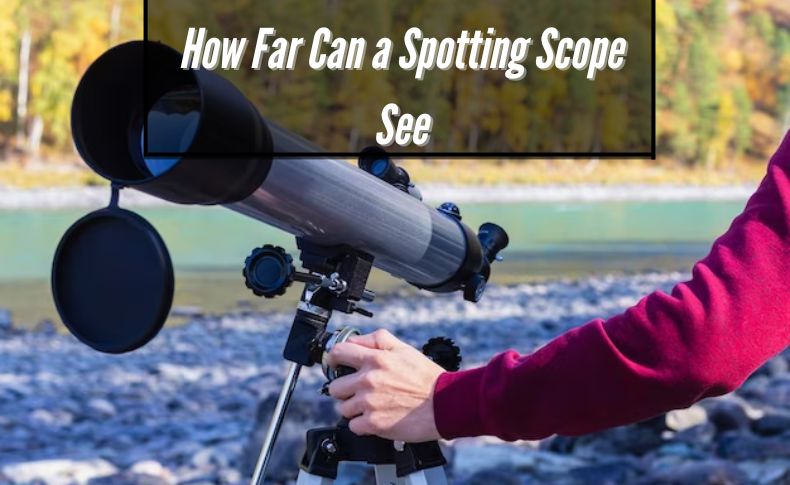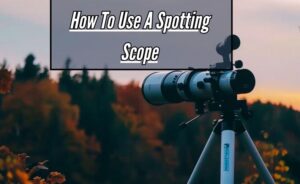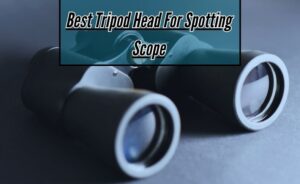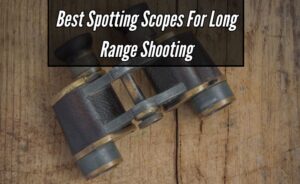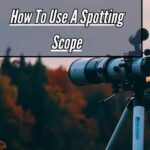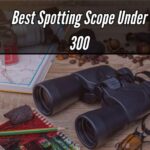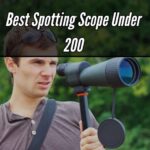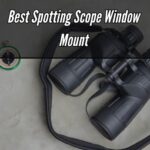Have you ever questioned how far a spotting scope can see? The ability to observe is a crucial component of every activity or line of work, whether you enjoy birdwatching, exploring nature, or hunting with a passion. Spotting scopes are a crucial tool for gaining a closer look at far-off things, but we frequently wonder what their genuine capabilities are.
How Far Can a Spotting Scope See? The range of a spotting scope varies with its specifications, but generally speaking, it can see objects clearly up to 1,000 yards (about 914 meters), or more. Even longer distances can be attained by high-quality scopes with bigger objective lenses and higher magnification.
In essence, a spotting scope is a small, portable telescope made for use on the ground. Beyond what the human eye can see, it provides magnification, and it has specialized optics that produce dazzling clarity and detail. However, even the best spotting scopes have a range limit.
Understanding Spotting Scopes: A Brief Introduction
Spotting scopes are essential tools for outdoor enthusiasts, nature lovers, and anyone who seeks a closer look at distant objects.
These versatile optical instruments bridge the gap between binoculars and telescopes, offering high magnification and clarity for various activities. In this brief introduction, we will explore the key aspects of spotting scopes to help you understand their functionality and utility.
Anatomy of a Spotting Scope
Spotting scopes consist of several components that work together to provide sharp, magnified views of distant subjects. At the heart of the scope is the objective lens, which collects and focuses light.
The eyepiece, positioned at the opposite end, magnifies the image formed by the objective lens. Spotting scopes are typically designed with an angled or straight body, allowing users to choose the most comfortable viewing angle. To stabilize the scope and improve viewing, they often come with a tripod mount.
Magnification and Objective Lens Size
One of the primary considerations when choosing a spotting scope is magnification. Spotting telescopes offer variable magnification, typically ranging from 15x to 60x or more. However, higher magnification isn’t always better, as it can result in reduced image brightness and a narrower field of view.
The size of the objective lens plays a crucial role in determining the scope’s light-gathering capability and low-light performance. A larger objective lens diameter allows for better performance in dim conditions, making it ideal for birdwatching or stargazing.
Field of View and Eye Relief
The field of view (FOV) is the area visible through the spotting scope at a specific magnification. A wider FOV is advantageous for tracking moving objects or scanning large landscapes, while a narrower FOV provides more detail at higher magnifications.
Additionally, eye relief is vital for comfortable viewing, especially for individuals who wear eyeglasses. Longer eye relief distances ensure that users can view the entire image without experiencing blackouts or vignetting.
Coatings and Optics Quality
Spotting scopes are equipped with various coatings on their lenses and prisms to enhance image quality. Look for scopes with fully multi-coated optics, as these coatings reduce glare, improve contrast, and transmit more light.
High-quality prisms, typically either Porro or roof prisms, contribute to the clarity and sharpness of the image. Investing in a spotting scope with superior optics is crucial for a satisfying viewing experience.
Applications and Accessories
Spotting scopes find application in a wide range of activities, including birdwatching, wildlife observation, target shooting, and astronomy.
To enhance their versatility, many spotting scopes can be paired with digiscoping adapters, allowing you to attach a smartphone or camera to capture stunning images or videos of distant subjects. Additionally, specialized eyepieces, filters, and carrying cases are available to cater to specific needs and preferences.
Factors Affecting Spotting Scope Range: Exploring the Limits

Spotting scopes are invaluable tools for outdoor enthusiasts, birdwatchers, hunters, and amateur astronomers, offering a closer look at distant objects. However, the effectiveness and range of a spotting scope can vary significantly due to a multitude of factors.
In this comprehensive note, we will delve into the key factors that affect the range of a spotting scope, helping you understand the limitations and how to optimize your viewing experience.
Optical Quality:
The optical quality of a spotting scope is paramount in determining its effective range. High-quality spotting scopes use premium lenses and coatings that minimize light dispersion and distortion, resulting in clearer and sharper images at greater distances.
Investing in a spotting telescope with superior optical components will significantly extend its range and enhance your viewing experience.
Objective Lens Diameter:
The size of the objective lens plays a critical role in determining a spotting scope’s range. A larger objective lens allows more light to enter the scope, resulting in brighter and more detailed images.
As a general rule, spotting telescopes with larger objective lenses have the potential to achieve longer ranges, making them ideal for long-distance observation. However, keep in mind that larger objective lenses also make the spotting scope heavier and bulkier.
Magnification:
While higher magnification may seem like the key to spotting distant objects, it’s important to strike a balance. Excessive magnification can lead to image instability, especially in windy conditions.
Moreover, higher magnification can exaggerate atmospheric distortions, limiting the effective range of the spotting scope. Finding the right balance between magnification and stability is crucial to maximizing the scope’s range.
Atmospheric Conditions:
The Earth’s atmosphere introduces a range of variables that can affect the range of a spotting scope. Atmospheric turbulence, caused by temperature differences and wind, can distort and blur distant images.
To overcome these challenges, consider using a tripod or mount to stabilize the scope, and choose viewing locations with minimal atmospheric disturbance. Additionally, viewing during optimal weather conditions, such as clear, calm days, will help extend the spotting scope’s effective range.
Exit Pupil Size:
The exit pupil size, calculated by dividing the objective lens diameter by the magnification, is an often-overlooked factor affecting spotting scope range. To maximize the scope’s range, ensure that the exit pupil matches or slightly exceeds the diameter of your eye’s pupil.
This alignment allows your eye to receive the maximum amount of light, resulting in a brighter and clearer image, especially in low-light conditions.
Spotting Scope Magnification: How It Impacts Viewing Distance

Spotting scopes are invaluable tools for nature enthusiasts, birdwatchers, hunters, and astronomers, allowing them to observe distant objects with clarity and precision. One crucial aspect of spotting scopes that significantly affects their performance is magnification.
In this comprehensive note, we’ll explore how spotting scope magnification impacts viewing distance and the factors to consider when choosing the right magnification for your needs.
Understanding Magnification
Magnification is the process of making distant objects appear larger and closer. It is typically expressed as a numerical value followed by an “x” (e.g., 20x, 60x), which represents how many times larger an object will appear when viewed through the scope compared to the naked eye.
Higher magnification levels can provide a more detailed view of distant objects, but they also come with certain trade-offs.
Image Stability and Brightness
Another factor to take into account is image stability and brightness. Higher magnification levels can make it more challenging to maintain a steady image, as the slightest hand movements become more pronounced.
Additionally, higher amplification can reduce the amount of light entering the scope, resulting in dimmer images, especially in low-light conditions. To counteract this, many spotting scopes feature image stabilization technology and larger objective lenses to gather more light, ensuring a clearer and more stable view.
Atmospheric Conditions and Viewing Distance
Spotting scope magnification can also be influenced by atmospheric conditions. On a clear day with minimal atmospheric distortion, higher magnification can allow you to see objects at greater distances.
However, in conditions with heatwaves, humidity, or other atmospheric disturbances, the image quality may degrade at high magnifications due to “mirage” effects. In such cases, reducing amplification can sometimes provide a more stable and viewable image.
Choosing the Right Magnification
When choosing a spotting scope, it’s essential to select the right magnification for your intended use. For birdwatching or general wildlife observation, a spotting telescope with lower magnification (e.g., 20–40x) is often recommended to maintain a broader field of view and image stability.
For long-range target shooting or astronomy, higher amplification (e.g., 60x or more) may be preferable to observe distant objects in detail.
Spotting Scope vs. Telescope: A Comparison of Viewing Distances
Spotting scopes and telescopes are both valuable tools for observing distant objects, but they serve different purposes and excel in specific areas.
When it comes to comparing their viewing distances, several key factors come into play, making it essential to understand the distinctions between these optical instruments.
Purpose and Design:
Spotting scopes are designed primarily for terrestrial observations, making them ideal for birdwatching, wildlife observation, and even some astronomy. They are compact and portable, with lower magnification levels but a wider field of view.
Telescopes, on the other hand, are specifically crafted for celestial observation, offering higher magnification capabilities, but a narrower field of view. The design and intended purpose greatly influence the viewing distances each instrument can achieve.
Magnification:
Telescopes typically offer higher magnification levels than spotting scopes. This increased amplification allows astronomers to observe celestial objects millions of miles away in incredible detail.
Telescopes are equipped with various eyepieces and specialized optics that enable them to zoom in on distant galaxies, stars, and planets. Spotting scopes, while providing clear views of distant terrestrial subjects, cannot match the magnification power of telescopes.
Field of View:
Spotting scopes excel in providing a wide field of view, making them well-suited for scanning landscapes, tracking moving wildlife, and conducting nature observations. This broader field of view allows users to cover more ground and locate objects more quickly.
Telescopes, with their narrower field of view, are designed for precision observation of specific celestial objects. They are meant for patient and detailed exploration of the night sky rather than quick scans.
Limitations and Adaptability:
Spotting scopes are versatile instruments that can be used for both terrestrial and astronomical viewing, albeit with limitations. While they can offer decent views of the moon and some brighter planets, they lack the specialized optics and tracking capabilities of telescopes, which are essential for deep-sky astronomy.
Telescopes are specifically engineered for celestial observation and are less adaptable for terrestrial use due to their narrow field of view and higher magnification.
Portability and Size:
Spotting scopes are generally more portable and easier to carry into the field, making them popular choices for nature enthusiasts and birdwatchers who need to move around.
Telescopes, particularly larger ones, tend to be bulkier and heavier, requiring more setup and transportation effort. However, for dedicated astronomers, the size and weight are justified by the exceptional celestial views they can provide.
Real-World Applications: How Far Can a Spotting Scope See in Different Environments?

Spotting scopes are versatile optical instruments known for their ability to magnify distant objects and deliver crisp, clear images. These scopes are widely used in various fields, from wildlife observation and birdwatching to target shooting and surveillance.
One critical aspect that determines the effectiveness of a spotting scope is its range or how far it can see in different environments. In this article, we will explore the real-world applications of spotting telescopes and examine the factors that influence their maximum viewing distance across diverse settings.
Wildlife Observation:
Spotting scopes are invaluable tools for wildlife enthusiasts and researchers. In dense forests, marshlands, and savannahs, wildlife observation scopes help observers to safely and unobtrusively study animals from a distance.
The range of a spotting telescope in these environments is affected by factors such as the size of the target animal, atmospheric conditions, and the optical quality of the scope. Skilled users can often spot wildlife at distances exceeding a mile, enabling the study of elusive and shy species without causing disturbance.
Birdwatching:
Birdwatchers rely on spotting scopes to identify and observe avian species in their natural habitats. The ability to see distant birds clearly is crucial, especially when dealing with small or rare species.
In open landscapes like wetlands, grasslands, and coastal areas, spotting telescopes can reach impressive distances, allowing enthusiasts to spot and document birds with incredible detail. In ideal conditions, some scopes can achieve viewing distances of up to two miles or more.
Target Shooting and Ballistics:
Spotting scopes are indispensable tools for target shooters, both in competitive sports and long-range precision shooting.
These scopes enable shooters to closely examine their shots on distant targets, helping them make necessary adjustments to improve accuracy. In a shooting range or on a vast open field, high-power telescopes can often see hits on targets up to a mile away, facilitating skill development and training.
Surveillance and Security:
Security professionals and law enforcement agencies use spotting scopes for surveillance and monitoring activities. Whether observing a crowd, monitoring a border, or conducting covert operations, the spotting scope’s range is vital for maintaining a safe distance while gathering essential information.
Advanced spotting telescopes with powerful magnification and clear optics can provide surveillance capabilities at distances exceeding two miles, making them indispensable tools in security applications.
Astronomy:
While telescopes are typically associated with astronomy, spotting scopes can also be used for celestial observation, especially for beginners and for portable stargazing.
In dark, open spaces with minimal light pollution, a spotting scope equipped with the right accessories can reveal details on the moon’s surface, distant planets, and even some deep-sky objects. Although spotting telescopes are not as powerful as telescopes designed for astronomical use, they offer a compact and versatile option for stargazers on the go.
Conclusion
In conclusion, a noteworthy feature of optical technology is the spotting scope’s field of view. Spotting telescopes may frequently extend one’s view to astounding distances, yet several parameters including magnification, objective lens diameter, and climatic conditions play vital roles in deciding its capabilities. These optical tools continue to push the limits of long-distance observation thanks to recent developments in lens coatings and image stabilization technologies.
It’s crucial to keep in mind that a spotting telescope’s actual range of vision is not only determined by its specs but also by the inherent restrictions of light and atmospheric distortion. Spotting scopes continue to be essential instruments for astronomers, wildlife watchers, and nature enthusiasts alike in their quest to discover far-off horizons.
Frequently Asked Questions (How Far Can a Spotting Scope See)
What factors affect the viewing distance of a spotting scope?
A spotting scope’s viewing distance is determined by a number of important variables. First and foremost, the optics’ quality is very important. Longer distances yield sharper images when using higher-quality optics. Second, the scope’s magnification power is important. You can see farther with higher magnification, but in order to prevent image blur, you might need a more solid installation.
Thirdly, viewing distance may be restricted by meteorological phenomena such as fog, haze, and mirage. In general, visibility is better in clear weather than in hazy or foggy ones. Finally, the objective lens’s size has a role as well; larger lenses capture more light, improving visibility. Taking these things into account enhances the spotting telescope viewing experience.
Is there a maximum useful magnification for spotting scopes?
Yes, spotting scopes have a maximum usable magnification. There is a limit to how much you can magnify before the quality of the image degrades, even if more amplification can make objects appear closer. The steadiness of the scope, air conditions, and optic quality all have an impact on this limit. Zoom strength, image stability, and clarity are all balanced at optimal magnification.
Excessive magnification can produce an unfocused or wobbly image, which makes it more difficult to see details. To guarantee that you obtain the ideal combination of amplification and image quality for your purposes, it’s critical to take the intended application and environmental factors into account when choosing a spotting scope.
How far can you see with a 20 60 spotting scope?
The range of vision you can achieve with a 20–60x magnification spotting scope is dependent on a number of variables. You can typically see farther away objects more clearly with increased magnification. Nonetheless, variables like meteorological conditions, lens quality, and objective lens size all affect how far you can actually see.
Under ideal circumstances, you might be able to clearly see objects at distances of several hundred yards at reduced magnification. The amplification may cause a picture to become more distorted or lose clarity owing to atmospheric factors, which could cause the distance to decrease. While using a spotting telescope to calculate the maximum useful distance for observation, it is imperative to take these considerations into account.
Can a spotting scope see clearly in low-light conditions?
Spotting scopes generally struggle to provide clear images in low-light conditions compared to bright daylight. The ability to see clearly in low light depends on factors like the quality of the optics and the size of the objective lens. Some spotting scopes feature special coatings or technologies to improve low-light performance, but they still may not match daytime clarity.
Additionally, using lower magnification settings can help gather more light, enhancing visibility in dim conditions. While spotting telescopes can still be used in low light, users may experience decreased image quality and clarity compared to daytime viewing. It’s essential to manage expectations and use appropriate settings when observing in low-light environments.
Can a spotting scope be used for surveillance or security purposes?
Given their capacity to magnify far-off objects, spotting scopes can be employed for security or surveillance applications. Users are able to keep an eye on locations without getting too close by using them to observe details or activities from a distance. Yet, a number of variables, like image quality, magnification strength, and the monitored environment, affect how successful they are for security purposes.
The appropriateness of certain spotting scopes for surveillance operations can be increased by adding capabilities like picture stabilization or low-light performance. Spotting telescopes are an invaluable tool for security experts, but in order to make sure they properly match the intended surveillance demands, it’s important to take certain variables and criteria into account.
What role do lens coatings play in spotting scope performance?
Lens coatings are essential for improving the performance of spotting scopes in a number of ways. These coatings work to increase light transmission, lessen glare, and improve the contrast and clarity of images. Lens coatings contribute to the production of clearer and brighter images by reducing reflections and maximizing light transmission, particularly in difficult lighting situations like intense sunlight or low light.
Furthermore, lens coatings can shield the lenses from moisture, dust, and scratches, extending the spotting scope’s life. When selecting the best optic for your needs, lens coatings play a critical role because they have a substantial impact on a spotting telescope’s overall performance and user experience.

